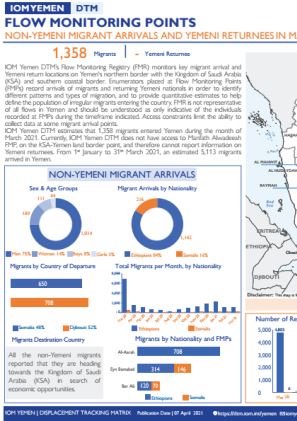-
Countries
-
Data and Analysis
-
Special Focus
-
Crisis Responses
Yemen - Flow Monitoring Points | Non-Yemeni Migrant Arrivals And Yemeni Returnees in March 2021

Contact
DTM Yemen, iomyemendtm@iom.int
Language
English
Location
Yemen
Period Covered
Mar 01 2021
Mar 31 2021
Activity
- Flow Monitoring Survey
- Flow Monitoring
- Mobility Tracking
- Baseline Assessment
IOM Yemen DTM’s Flow Monitoring Registry (FMR) monitors key migrant arrival and Yemeni return locations on Yemen's northern border with the Kingdom of Saudi Arabia (KSA) and southern coastal border. Enumerators placed at Flow Monitoring Points (FMPs) record arrivals of migrants and returning Yemeni nationals in order to identify different patterns and types of migration, and to provide quantitative estimates to help define the population of irregular migrants entering the country. FMR is not representative of all flows in Yemen and should be understood as only indicative of the individuals recorded at FMPs during the timeframe indicated. Access constraints limit the ability to collect data at some migrant arrival points.
From 01 to 31 March 2021, IOM Yemen DTM estimates that 1,358 migrants arrived in Yemen. The migrant caseload was 84 per cent Ethiopian and 16 per cent Somali, with 100% of those tracked heading for Saudi Arabia. The migrants are predominantly male (75%), with 14 per cent women, eight per cent boys and three per cent girls also among the travelers.
Through March reporting period, 650 migrants arrived from Somalia and were recorded at Eyn Bamabad (460 migrants) and Ber Ali (190 migrants) flow monitoring points in Shabwah governorate. Al Aarah flow monitoring point in Lahj governorate saw the highest number of migrant arrivals, with 708 migrants arriving from Djibouti.
METHODOLOGY:
DTM’s global flow monitoring methodology aims to identify areas prone to internal, cross-border and regional migration. Mobility area assessments are conducted at the national level. DTM teams then collect information at the local level to identify key transit points. Enumerators collect data from key informants at the flow monitoring points: key informants may be transport staff, custom officers, boat operators or migrants themselves. Data is collected through a basic form combined with direct observations –enabling breakdowns.
LIMITATIONS:
Data collected for these exercises should be understood as estimations only. They represent only part of the total flows passing through Yemen. The spatial and temporal coverage of this data collection activity is therefore incomplete. In addition, although data is collected daily, it is collected only during peak hours. The portion of the flows that occur during the uncovered hours is not represented. Data on vulnerability is based on direct observation and should be understood as mainly indicative.
